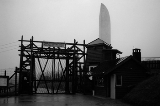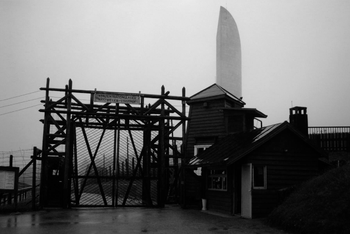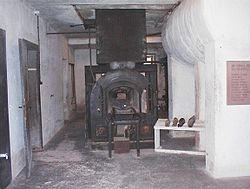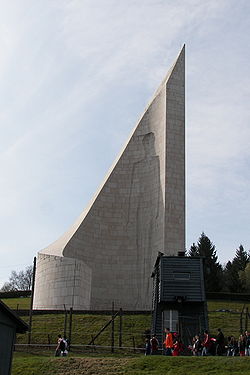
Natzweiler-Struthof
Encyclopedia

Nazi Germany
Nazi Germany , also known as the Third Reich , but officially called German Reich from 1933 to 1943 and Greater German Reich from 26 June 1943 onward, is the name commonly used to refer to the state of Germany from 1933 to 1945, when it was a totalitarian dictatorship ruled by...
concentration camp located in the Vosges Mountains
Vosges mountains
For the department of France of the same name, see Vosges.The Vosges are a range of low mountains in eastern France, near its border with Germany. They extend along the west side of the Rhine valley in a northnortheast direction, mainly from Belfort to Saverne...
close to the Alsatian
Alsace
Alsace is the fifth-smallest of the 27 regions of France in land area , and the smallest in metropolitan France. It is also the seventh-most densely populated region in France and third most densely populated region in metropolitan France, with ca. 220 inhabitants per km²...
village of Natzwiller
Natzwiller
Natzwiller is a commune in the Bas-Rhin department in Alsace in north-eastern France.-History:Built around 1941 on the territory of the commune, Natzweiler-Struthof was the only Nazi concentration camp on French soil. The inmates originally were German who were to supply labor for building V-2...
(German Natzweiler) in France
France
The French Republic , The French Republic , The French Republic , (commonly known as France , is a unitary semi-presidential republic in Western Europe with several overseas territories and islands located on other continents and in the Indian, Pacific, and Atlantic oceans. Metropolitan France...
, and the town of Schirmeck, about 50 km south west from the city of Strasbourg
Strasbourg
Strasbourg is the capital and principal city of the Alsace region in eastern France and is the official seat of the European Parliament. Located close to the border with Germany, it is the capital of the Bas-Rhin département. The city and the region of Alsace are historically German-speaking,...
.
Natzweiler-Struthof was the only concentration camp established by the Nazis on present-day French
France
The French Republic , The French Republic , The French Republic , (commonly known as France , is a unitary semi-presidential republic in Western Europe with several overseas territories and islands located on other continents and in the Indian, Pacific, and Atlantic oceans. Metropolitan France...
territory, though there were French-run temporary camps such as the one at Drancy. At the time, the Alsace-Lorraine
Alsace-Lorraine
The Imperial Territory of Alsace-Lorraine was a territory created by the German Empire in 1871 after it annexed most of Alsace and the Moselle region of Lorraine following its victory in the Franco-Prussian War. The Alsatian part lay in the Rhine Valley on the west bank of the Rhine River and east...
area in which it was established was administered by Germany as an integral part of the German Reich.
The writer Boris Pahor
Boris Pahor
Boris Pahor is a Slovene writer from Italy. He is considered to be one of the most influential living authors in the Slovene language and has been nominated for the Nobel prize for literature by the Slovenian Academy of Sciences and Arts...
was interned in Natzweiler-Struthof and wrote his novel Necropolis based on this experience.
Operations

Schutzstaffel
The Schutzstaffel |Sig runes]]) was a major paramilitary organization under Adolf Hitler and the Nazi Party. Built upon the Nazi ideology, the SS under Heinrich Himmler's command was responsible for many of the crimes against humanity during World War II...
evacuated the camp into Dachau. Its construction was overseen by Hans Hüttig
Hans Hüttig
Hans Hüttig was a German Schutzstaffel officer and Nazi concentration camp commandant....
. The camp was evacuated and sent on a "Death march
Death march
A death march is a forced march of prisoners of war or other captives or deportees. Those marching must walk over long distances for an extremely long period of time and are not supplied with food or water...
" on early September 1944 with only a small SS unit keeping the camp's operations, and on November 23, 1944, discovered and liberated by American Allies as the first concentration camp in Western Europe. Its system of subcamps is listed in List of subcamps of Natzweiler-Struthof.
The total number of prisoners reached an estimated 52,000 over the three years originating from various countries including Poland
Poland
Poland , officially the Republic of Poland , is a country in Central Europe bordered by Germany to the west; the Czech Republic and Slovakia to the south; Ukraine, Belarus and Lithuania to the east; and the Baltic Sea and Kaliningrad Oblast, a Russian exclave, to the north...
, the Soviet Union
Soviet Union
The Soviet Union , officially the Union of Soviet Socialist Republics , was a constitutionally socialist state that existed in Eurasia between 1922 and 1991....
, the Netherlands
Netherlands
The Netherlands is a constituent country of the Kingdom of the Netherlands, located mainly in North-West Europe and with several islands in the Caribbean. Mainland Netherlands borders the North Sea to the north and west, Belgium to the south, and Germany to the east, and shares maritime borders...
, France
France
The French Republic , The French Republic , The French Republic , (commonly known as France , is a unitary semi-presidential republic in Western Europe with several overseas territories and islands located on other continents and in the Indian, Pacific, and Atlantic oceans. Metropolitan France...
, Germany
Germany
Germany , officially the Federal Republic of Germany , is a federal parliamentary republic in Europe. The country consists of 16 states while the capital and largest city is Berlin. Germany covers an area of 357,021 km2 and has a largely temperate seasonal climate...
and Norway
Norway
Norway , officially the Kingdom of Norway, is a Nordic unitary constitutional monarchy whose territory comprises the western portion of the Scandinavian Peninsula, Jan Mayen, and the Arctic archipelago of Svalbard and Bouvet Island. Norway has a total area of and a population of about 4.9 million...
. The camp was specially set up for Nacht und Nebel
Nacht und Nebel
Nacht und Nebel was a directive of Adolf Hitler on 7 December 1941 signed and implemented by Armed Forces High Command Chief Wilhelm Keitel, resulting in the kidnapping and forced disappearance of many political activists and resistance 'helpers' throughout Nazi Germany's occupied...
prisoners, in most cases people of the resistance movements. They were to be destroyed by labour and disappear without their relatives knowing their fate.
The camp holds also a crematorium and a jury rigged gas chamber
Gas chamber
A gas chamber is an apparatus for killing humans or animals with gas, consisting of a sealed chamber into which a poisonous or asphyxiant gas is introduced. The most commonly used poisonous agent is hydrogen cyanide; carbon dioxide and carbon monoxide have also been used...
outside the main camp, which was not used for mass extermination; 86 Jewish men and women were gassed in it, 80 of them personally by Josef Kramer
Josef Kramer
Josef Kramer was the Commandant of the Bergen-Belsen concentration camp. Dubbed "The Beast of Belsen" by camp inmates; he was a notorious Nazi war criminal, directly responsible for the deaths of thousands of people...
to provide 'anatomical specimens' for the Jewish skeleton collection
Jewish skeleton collection
The Jewish skeleton collection was an attempt by the Nazis to create an anthropological display to showcase the alleged racial inferiority of the "Jewish race" and to emphasize the Jews status as untermenschen as opposed to the German race which the Nazis considered to be Aryan ubermenschen...
for August Hirt
August Hirt
August Hirt , an SS-Hauptsturmführer , served as a chairman at the Reich University in Strasbourg during World War II....
's anatomical laboratory of the Reich University of Strasbourg
Reichsuniversität Straßburg
The Reichsuniversität Straßburg was founded 1941 by the National Socialists in Alsace while the regular University of Strasbourg had moved to Clermont-Ferrand since 1940. The purpose was to create a continuity to the German character of the German Imperial University of Strasbourg, that had been...
, France.
Strenuous work, medical experiments, poor nutrition and mistreatment by the SS guards resulted in an estimated 25,000 deaths. Among those who died here were four female SOE
Special Operations Executive
The Special Operations Executive was a World War II organisation of the United Kingdom. It was officially formed by Prime Minister Winston Churchill and Minister of Economic Warfare Hugh Dalton on 22 July 1940, to conduct guerrilla warfare against the Axis powers and to instruct and aid local...
agents executed together on July 6, 1944: Diana Rowden
Diana Rowden
Diana Hope Rowden MBE was a Special Operations Executive member who was executed in a Nazi concentration camp.-Early life:...
, Vera Leigh
Vera Leigh
Vera Leigh was a British spy during World War II who assisted the French Resistance. In 1944 she was captured by the Germans and executed.-Early life:...
, Andrée Borrel
Andrée Borrel
Andrée Raymonde Borrel was a French heroine of World War II.-Early life:Andrée Borrel was born into a working-class family in Louveciennes, Yvelines in the suburbs of Paris, growing up an active girl who liked hiking and most other outdoor activities...
and Sonya Olschanezky
Sonya Olschanezky
Sonya Olschanezky was a member of the French Resistance during World War II. The daughter of a Russian Jew, Eli Olschanezky, a chemical engineer who worked as a sales representative for a manufacturer of ladies' stockings, she was seven years old when the family moved to Paris, France and her...
. Since the female prisoner population in the camp was small, only seven SS women served in Natzweiler Struthof camp (compared to more than 600 SS men), and 15 in the Natzweiler complex of subcamps. The main duty of the female supervisors in Natzweiler was to guard the few women who came to the camp for medical experiments or to be executed. The camp also trained several female guards who went to the Geisenheim
Geisenheim
Geisenheim is a town in the Rheingau-Taunus-Kreis in the Regierungsbezirk of Darmstadt in Hessen, Germany, and is known as Weinstadt , Schulstadt , Domstadt and Lindenstadt ....
and Geislingen
Geislingen
Geislingen can refer to:two towns in Baden-Württemberg, Germany:* Geislingen an der Steige, district of Göppingen.* Geislingen, Zollernalbkreis, Zollernalbkreis district....
subcamps in western Germany.
Among the inmates were also the Norwegian resistant Per Jacobsen
Per Jacobsen
Per Jacobsen was a Norwegian figure skater , and a resistance member who was killed during World War II.-Early and personal life:...
who died there and Charles Delestraint
Charles Delestraint
Charles Delestraint was a French Army general and member of the French Resistance during World War II.He was born in Biache Saint-Waast, Pas-de-Calais....
, leader of the Armée Secrète
Armée secrète
The Armée secrète, created in 1943, was an organisation of French resistance fighters during World War II set up by Jean Moulin. It resulted from an amalgamation of three smaller resistance groups:*Combat*Libération-Sud*Franc-Tireur...
who died later in Dachau.

- Boris PahorBoris PahorBoris Pahor is a Slovene writer from Italy. He is considered to be one of the most influential living authors in the Slovene language and has been nominated for the Nobel prize for literature by the Slovenian Academy of Sciences and Arts...
, Necropolis, 1967 - Willem Lodewijk Harthoorn, Verboden te sterven, Van Gruting, 2007, ISBN 9789075879377
- Hinke Piersma, Doodstraf op termijn 2006, Walburg Pers, ISBN 9057304422
- Floris Bakels, Nacht und Nebel; mijn verhaal uit Duitse gevangenissen en concentratiekampen, Elsevier, 1977, ISBN 9043503665, written as an historical account by a former inmate, based on interviews and research, memoirs of the former prime minister of Norway
Post-war criminal trials

Fritz Hartjenstein
Friedrich "Fritz" Hartjenstein was an SS-Obersturmbannführer in the SS-Totenkopfverbände...
died in prison before his sentence could be carried out. The remaining two death sentences were carried out by hanging, on October 11, 1946. Those tried were:
- Franz Berg: death sentence (executed)
- Kurt Geigling: 10 years imprisonment
- Fritz HartjensteinFritz HartjensteinFriedrich "Fritz" Hartjenstein was an SS-Obersturmbannführer in the SS-Totenkopfverbände...
(commandant): death sentence (died before sentence was carried out) - Josef Muth: 15 years imprisonment
- Peter Straub: death sentence (executed)
- Magnus Wochner: 10 years imprisonment
Magnus Wochner was also implicated in the Stalag Luft III murders
Stalag Luft III murders
The Stalag Luft III murders was a war crime perpetrated by members of the Gestapo following the "Great Escape" of Allied prisoners of war from the German Air Force prison camp known as Stalag Luft III on March 25, 1944. Of a total of 76 successful escapees, 73 were recaptured, mostly within days of...
and was listed among the accused.

